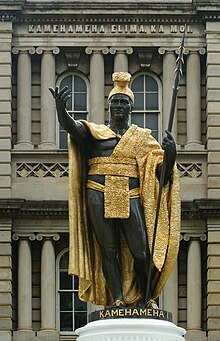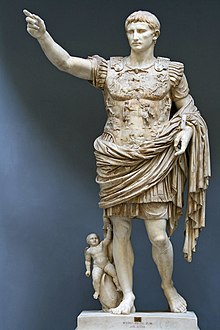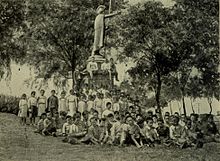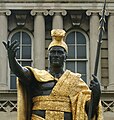Statues of Kamehameha I.
The statues of Kamehameha I are a larger than life bronze statue of the first king of Hawaii, Kamehameha I , modeled in 1880 by the American sculptor Thomas R. Gould , and several later casts and reproductions that were made in Hawaii, Washington, DC and on other locations.
The original statue was to be erected in front of the Aliʻiōlani Hale government seat in Honolulu. It was initially lost on the transport from the foundry in Paris to Honolulu due to shipwreck near the Falkland Islands in the South Atlantic , so a second casting of the original mold was commissioned. This second cast was placed in front of the Aliʻiōlani Hale. The original statue was salvaged by fishermen and, as it was in worse condition than the replica, was placed in front of the old courthouse of Kapaʻau in Hawaii County , near the birthplace of Kamehamehas. In 1969 the State of Hawaii donated two statues to the National Statuary Hall Collection of the Capitol in Washington, DC, one of which is a cast of the statues of Kamehameha I in Hawaii.
In Hawaii, the statues of Kamehameha are important elements in reflecting on Hawaiian culture and spirituality. Images of the Honolulu statue are featured in the Hawaiian seal and numerous organization and corporate logos. As a popular photo motif and through their use in films, for example in the opening credits of the television series Hawaii Five-Zero and its remake Hawaii Five-0 , they became a symbol of Hawaii worldwide.
background
In 1878, the American adventurer, newspaper publisher and later Secretary of State and Prime Minister Walter M. Gibson , newly elected to the House of Representatives from Hawaii, suggested the erection of a sculpture to celebrate the 100th anniversary of the landing of James Cook in Hawaii. Parliament set for this purpose 10,000 dollars ready and appointed Gibson as chairman of a committee for the implementation and monitoring of the project. The committee initially included Hawaiians, but it was heavily dominated by Gibson and King David Kalākaua .
Gibson searched for a while in various American cities for a suitable sculptor and finally hired Thomas R. Gould , a sculptor from Boston who mainly lived and worked in Florence .
draft
At an early stage of the design, the intention was to exactly replicate the face, physique and clothing of King Kamehameha I. This faced insurmountable difficulties; the appearance of Kamehameha could not be determined for any characteristic. On a visit to Gould's in Boston, Gibson brought him an engraving , which was a French copy of a Chinese copy of the portrait made in 1816 by the Russian painter and explorer Louis Choris .
Gould was instructed to model Kamehameha's face from the submitted copy of the copy of a portrait that showed Kamehameha I as an old man, but portrayed him as being significantly younger than 45. The physique is also not realistic. Since on the one hand there was no reliable information about Kamehameha's stature, on the other hand a heroic warrior king was to be depicted, it was decided to depict it with a broad back and shoulders, strong arms and a prominently protruding chin - in the style of the classical depictions of Heracles , but fictitious .
There are clear indications that Thomas R. Gould used the ancient Roman marble statue of Augustus of Primaporta found in 1863 as a template for his depiction of Kamehameha I. After its discovery, the statue was the subject of extensive and well-educated reports. As a visual artist who lived and worked in Florence and often used ancient motifs, Gould must have known the statue on display in the Vatican Museums . Both statues are united by the gesture of the raised and forward-pointing but not quite outstretched right arm. Unlike today, in the 19th century it was believed that the ancient statue must have held a spear in its left hand. It was exhibited with a reconstructed spear and the images with the spear went around the world. The statue of Kamehameha was also given a spear in the left hand, although the prevailing opinion was that the king was right-handed. Both statues show the person represented with the body weight on the right standing leg and with the left leg slightly bent.
It was believed that the synthesis of classic Hawaiian motifs such as the king's clothing and motifs borrowed from ancient Roman art should idealize Kamehameha I as a "Pacific hero" in a targeted manner. This enabled the troubled monarchy to be supported in a phase of political and economic upheaval.
King Kalākaua commissioned several photos of Hawaiians in traditional clothing from the Danish engineer and photography pioneer Christian Hedemann, who lives in Hawaii , so that they could serve Gould as a template for the statue. Two of these photos by court official John Timoteo Baker have survived . The first picture shows him in a Hawaiian feather cape with a feather helmet, but with European dark linen trousers. The second shot is a photomontage, for which John Timoteo Baker's picture was added with the uncovered pair of athletic legs of his brother Robert Hoapili Baker , possibly also an unknown fisherman.
The photos by John Timoteo Baker show him in the precious traditional clothing of a Hawaiian king, which has been preserved in the Bernice Pauahi Bishop Museum to this day. The royal regalia included the feather-trimmed sash ( Hawaiian kāʻei ) wrapped around his body and thrown over his left shoulder , the feather helmet ( mahiole ) and his cloak ( ʻahu ʻula ). The sash is modeled on Līloas Kāʻei , the sash of the legendary King Līloa of the island of Hawaii. Līloa ruled in the late 15th century and the sash could be dated to the early 15th century using the radiocarbon method. It is more than four meters long and is kept as one of the most valuable artifacts in the Bernice Pauahi Bishop Museum in Honolulu. The red ribbon in the middle of the sash probably consists of small feathers from the now endangered species ʻIʻiwi (Latin: Drepanis coccineus ), the two yellow ribbons on the sides of feathers from the magnificent moho , which died out in the 20th century ( Hawaiʻi ʻōʻō ; Latin: Moho nobilis ). The cloak consists of approximately 450,000 golden-yellow feathers from around 80,000 specimens of the King's Dressing Bird ( Hawaiʻi mamo ; Latin: Drepanis pacifica ), which died out around 1899 .
- Templates for the statue
John Timoteo Baker (1878 to 1880)
Robert Hoapili Baker , around 1900
Augustus of Primaporta , found in 1863, photo taken before 1880
Līloas Kāʻei on an oil painting from 1890
In order to avoid possible criticism from the American or Hawaiian side, Gould and Kalākaua endeavored to observe a variety of Hawaiian traditions and the correct representation of royal insignia. But some elements of the presentation are criticized to this day. The representation of Kamehameha in sandals is not accepted. Sandals in Hawaii Kamehamehas were only worn on long walks and in rough terrain, and the unmistakably Western style of the sandals adds to the historical inaccuracy. The sash Kamehameha touched behind the king the floor, almost like a train in a European style. This contradicts Hawaiian tradition that it would be a degrading attitude to the king, it would desecrate the sash, and it would damage the precious feathers. In addition, the cape has a tassel , again an inauthentic accessory that is only conceivable in Europe.
Kamehameha's gesture, which symbolizes a summoning to the gathering, has only recently been criticized. It is claimed that the traditional Hawaiian gesture was made with the palm down. The execution by Gould shows a beckoning in the North American or European manner.

First cast (Kapaʻau, Hawaii County, Big Island)
1880 Gould had completed the model of the statue and sent it to the art foundry of Ferdinand Barbedienne in Paris . The finished statue was shipped to Bremen on August 21, 1880 . During a storm in the South Atlantic a fire broke out on deck, the ship ran onto a reef near the Falkland Islands and sank. The ship and all of its cargo were considered lost. Therefore, a new casting was commissioned, which should be paid for with the insurance sum of the supposedly lost first casting. Local fishermen managed to recover the statue. She was identified by a British captain and sold to the Hawaiian government in 1882 for $ 875. After some debates, the government of Hawaii decided that this first statue, damaged by the effects of the seawater and the salvage, should not be placed in front of the Aliʻiōlani Hale, but in front of the old courthouse of Kapaʻau ( 20 ° 13 ′ 49 ″ N , 155 ° 47 ′ 54 ″ W ) in Hawaii County on the main island of Hawaii .
Like its replica in Honolulu, the statue was originally patinated and partially gilded. The surface of the statue was corroded by contact with seawater after the wreck of the cargo ship and was already badly damaged when it arrived in Hawaii in 1883. The lack of material and expertise prevented a new patination and gilding and there was great time pressure, because the statue was to be unveiled by King Kalākaua in May 1883 . Therefore, the statue was only cleaned and painted completely brown. Sometime between 1883 and 1912, the population took up the tradition of multi-colored painting, which has continued to this day.
On Kamehameha Day, a parade moves from Hawi to Kapaʻau, it ends shortly after passing the statue. Many participants stop briefly at the statue to make offerings.
restoration
Responsibility for maintaining the statue has been difficult to determine since it was erected. It stands on Hawaii County property, but it is not certain that it is state owned. According to older residents of Kapa'au, the owners of the local sugar factory used to take care of the statue. Sometime after World War II , Hawaii County government officials took over the maintenance of the statue, which was taken over by the state of Hawaii as part of a 1973 public administration restructuring. These workers had no experience of cleaning and caring for works of art; they worked with wire brushes, high-pressure cleaners and household paints. No budget has been made available for this work since 1992. The state Hawaii State Foundation on Culture and the Arts , which is responsible for art in public spaces in Hawaii and is responsible for the second casting of the statue in Honolulu on Oʻahu, does not spend any funds on the original of the statue in Kapaʻau. Local residents suspect that this is a reaction to the local custom of painting the statue in multiple colors. Between 1992 and 2001, cleaning, painting and other maintenance work were carried out exclusively by residents using household resources.
After working on the gilding of the statue in Honolulu, Glenn Wharton was commissioned in the spring of 1996 to restore the statue in Kapaʻau to its original 1883 state. During his first visit, Wharton noticed that the paint on the statue had faded from the UV radiation of the sunlight , had peeled off the metal substrate in many areas and had peeled off in several places. The damage visible there was later identified by Wharton as bronze disease. This is a form of corrosion that can destroy the surfaces of copper , brass and bronze when exposed to chlorine salts such as sea salt, water and oxygen. Without countermeasures, damage to the surfaces can occur, which on the outside only appear as small holes, but expand inwards in the form of deep funnels. Wharton also found that the internal iron support structure had corroded and that there had been stress cracks in the metal base plate . All of this damage had to be worked on as part of the restoration.
A major challenge for the conservators was to determine the original appearance of the statue, as restoration work basically aims to restore the original state of a work of art created by the artist. While the statue in Honolulu has been left in its original appearance to this day, the statue in Kapaʻau has been painted in multiple colors for generations and it was unclear whether it was not already painted when it was erected. Contemporary reports were so contradicting the description of the statue that they could not be used in the restoration. Therefore, material samples were taken from the surface of the statue and examined using X-ray fluorescence and X-ray structure analysis. Remnants of the original gold frame could be found on the inner surface of some paint particles . This proved that the statue was initially patinated like the cast in Honolulu and partially covered with gold leaf.
Although there was no doubt about the original appearance of the statue, because of the great spiritual importance of the statue, the local population should be involved in the decision on the type of restoration. The original condition spoke in favor of the gilding; in addition, the appearance of the statue in Honolulu was often perceived as more aesthetically pleasing. In contrast, the multicolored painting of the statue would have given it a lifelike appearance and it would have been an expression of respect for a local tradition practiced for generations.
In the course of the public debate, children in local day-care centers and schools were brought up to date with the topic, also in order to indirectly reach their parents, groups and individuals engaged in local history dealt with the history of the statue and the plans for its restoration, and one was found extensive coverage in the local and regional media on the issue of gilding or painting. In 2000, the council of the community elders ( kūpana ) was first obtained, who spoke out in favor of keeping the painting. In a local citizen survey carried out at the end of the year, 71 percent of the participants were in favor of the painting.
Work on the statue began in February 2001. Following the documentation of the condition, the layers of paint were removed with the help of high-pressure cleaners, gas burners and solvents. After exposing the bronze surface, the stress cracks and depressions in the metal could be examined more closely. They were of an older date and were probably made when the statue was recovered from the sea.
A large part of the traces of the bronze disease had already been removed during cleaning. The remaining holes and cracks in the surface were filled with a pH-neutral epoxy resin and the bare bronze surfaces were fogged with benzotriazole to protect against renewed corrosion . The brown shade for Kamehameha's skin and the yellow and red of the clothes were chosen with the greatest care. The new version should be able to withstand the strong sunlight as well as the rain and the salty air of Hawaii. Therefore an anti-corrosion primer based on epoxy resin was applied first. Then came a basecoat of polyurethane-based one is also based on polyurethane and a third layer clear coat . At the end of the restoration, local volunteers were instructed in the annual maintenance and in the professional examination for damage and its documentation.
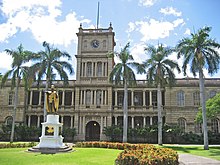
Second cast (before the Aliʻiōlani Hale, Honolulu, Oʻahu)
The second cast of the statue was installed in place of the damaged first version in front of the Aliʻiōlani Hale ( 21 ° 18 ′ 20.5 ″ N , 157 ° 51 ′ 34.7 ″ W ) in Honolulu on the island of Oʻahu . The original goal of erecting the statue on the 100th anniversary of Cook's arrival in Hawaii was clearly missed. Walter M. Gibson was able to convince King Kalākaua to undertake the unveiling of the statue during his coronation celebrations on February 12, 1883.
The statue has a patinated surface and is partially gilded.
The state Hawaii State Foundation on Culture and the Arts has been responsible for the maintenance and preservation of the statue since 1967. In 1994 the statue was re-gilded with the participation of Californian restorer Glenn Wharton.
- Second casting before the Aliʻiōlani Hale
For Kamehameha Day with lei nā decorated
Refit for the National Statuary Hall Collection, Washington, DC
The United States' National Statuary Hall Collection consists of two statues each donated by the fifty states . On the occasion of the 1959 admission of the Territory of Hawaii as the 50th state to the United States, a cast of the statue of Gould was made in Honolulu. The second statue in Hawaii shows Damian de Veuster , who died of leprosy on Molokaʻi in 1889 , has been a saint of the Roman Catholic Church and patron saint of leprosy and AIDS patients since 2009 . Both statues were donated to the National Statuary Hall Collection on April 15, 1969 during a ceremony in the rotunda of the United States Capitol . In June 1969, the Kamehamehas statue was placed in the National Statuary Hall ( 38 ° 53 ′ 24.4 ″ N , 77 ° 0 ′ 32.5 ″ W ). With a weight of 15 tons , including six tons for the granite plinth, the Kamehameha I statue is the heaviest in the collection.
In 2008, shortly after Barack Obama's nomination for the Democratic Party candidate for the 2008 presidential election , the Kamehameha statue was moved from a back row in Statuary Hall to a prominent position in Emancipation Hall by the Capitol Visitor Center. Every year a celebration with hula and other Hawaiian customs takes place here on or around Kamehameha Day .

Reproduction in Hilo, Big Island
In downtown Hilo, Hawaii, a fourth statue is located in a public park, the Wailoa River State Recreation Area ( 19 ° 43 ′ 14.8 ″ N , 155 ° 4 ′ 36.6 ″ W ). It is about 4.30 meters high and not a cast of the statue of Gould, but was sculpted in 1963 by the Italian sculptor Romeo Sandrin and cast in the Fracaro foundry in Vicenza . The client was the operator of an amusement park in Princeville on the island of Kaua'i , who paid 125,000 US dollars for the statue . When the plans became known, resistance arose among the population of the island, as Kaua'i, the only main island in the archipelago, was never conquered by Kamehameha I. The statue was put into storage and only erected in 1997 through the mediation of an organization of the alumni of the Kamehameha Schools in Hilo.
Reproduction in Wailea, Maui
Opposite the entrance to the Grand Wailea Resort Hotel & Spa ( 20 ° 41 ′ 4 ″ N , 156 ° 26 ′ 25.7 ″ W ) on Wailea Beach is the fifth statue. It was created by the Hawaiian artist, writer and historian Herb Kawainui Kane and is called The Young Kamehameha . The approximately three meter high statue is considered to be the one that comes closest to the appearance of Kamehameha.
Reproduction in Las Vegas, Nevada
In Las Vegas , Nevada , a statue of Kamehamehas was located in front of the Hawaiian Marketplace restaurant and shopping center ( 36 ° 6 ′ 23 ″ N , 115 ° 10 ′ 19.8 ″ W ) on the southern Las Vegas Strip . It was removed in January 2014 to make way for a new building for the Chili's Bar & Grill restaurant chain .

Spiritual and cultural significance
At the time of their installation, the first two statues were not objects of spiritual worship, and they were made by an American sculptor with significant Western influence. Since then, a change has taken place in the way the Hawaiians viewed it, which was also reflected in the painting of the statue in Kapa'au. Today, the statues are not only an important economic factor for tourists, but also evidence of Hawaiian culture and objects of religious worship. Some Hawaiians consider them to be carriers of mana , a divine or supernatural power. They have also been associated with the kiʻi , small ritual figures from before James Cook arrived in Hawaii. Ethnologists are unsure of the meaning of kiʻi , but oral tradition sees it in the roles of gods and spirits ( akua ), as the embodiment of natural phenomena and as representations of household or family gods or ancestors elevated to gods ( āumaka ). That the Ki'i inherent Mana was by special prayers or offerings ( hooknia Okupu be increased). Some Hawaiians consider any pictorial representation of Kamehameha to be a very powerful kiʻi , even if it is a product of Western influence such as the statues. Often offerings such as food, flower wreaths and stones ( pōhaku ) are presented on the bases of the statues . Even Hawaiians who do not believe in a mana in the statues respect them as images of the revered God-King Kamehameha I and as memories of the history of their ancestors.
The statues play an important role in the annual two-day celebrations for Kamehameha Day starting June 11, in which a large part of the population takes part. The celebrations include the performance of hula , songs and chants, and the sharing of stories about Kamehameha and ancient Hawaii. Delegations from all the islands of Hawaii visit the statues in Honolulu and Kapaʻau and decorate them with long garlands ( nā lei ) made of flowers, leaves, feathers or other materials.

Everyday culture
The statue of Kamehameha in Honolulu has become the political symbol of Hawaii, similar to the portraits of ruling princes on coins, postage stamps and banknotes from other states. It is depicted on the Hawaiian seal and is part of the logo of the Kamehameha Schools and numerous other Hawaiian organizations and companies. Both the Kingdom of Hawaii , the Republic of Hawaii and the Territory of Hawaii issued postage stamps depicting the statue of Kamehamehas I in the late 19th century. A 3-cent United States postage stamp issued in October 1937 honoring the Territory of Hawaii, founded in 1898, and also featured the statue. Even two fancy high-face stamps printed in 1886 by a group of London stamp dealers and forgers show the statue of Kamehameha.
On coins, the image of a Hawaiian warrior on the silver half dollar of the United States for the 150th anniversary of the landing of James Cook in Hawaii was obviously designed after the statue of Kamehameha. The State Quarter for Hawaii, issued in 2008, shows the statue. In addition, the statue was repeatedly depicted on postage stamps and coins from other countries. This applies in particular to those countries that are represented by international stamp and coin agencies and issue large numbers of attractive motifs on stamps without postal service or coins without monetary policy necessity.
The statues of Kamehameha are popular photo opportunities and they symbolize Hawaii in many films and TV shows. The statue of Honolulu appears in the opening credits of the television series Hawaii Five-Zero and its remake Hawaii Five-0 . In the episode The Rings of the Medici of the fourth season of Hawaii Five-0, the whole plot is set around the statue and its story.
- The statue of Kamehameha I in everyday culture
Kingdom of Hawaii , 25 cents postage stamp, 1883
Republic of Hawaii , 25 cents stamp from 1883 with overprint, 1893
Hawaii Territory , 5 cent postage stamp, 1899
Draft State Quarter for Hawaii, 2008
Web links
- Statuary Hall Kamehameha statue , Website Architects of the Capitol
- 5 King Kamehameha Statues , Tamerlane's Thoughts private blog with images of five of the statues
literature
- James E. Kloetzel et al .: Scott 2009 Standard Postage Stamp Catalog, Volume 1, A-B . Scott Publishing Co., Sidney, Ohio 2008, ISBN 0-89487-417-9 ;
- Glenn Wharton: The Painted King. Art, Activism, and Authenticity in Hawaiʻi . University of Hawaii Press, Honolulu 2012, ISBN 978-0-8248-3495-1 ;
Individual evidence
- ^ Glenn Wharton: The Painted King , p. 20.
- ^ Glenn Wharton: The Painted King , p. 22.
- ↑ Charlot, John. 1979. "That Statue of Kamehameha." Honolulu 13 (9): 35-40.
- ^ Glenn Wharton: The Painted King , p. 18.
- ↑ Jacob Adler: The Kamehameha Statue . In: Hawaiian Journal of History 1969, Volume 3, pp. 87-91.
- ↑ Jacob Adler: Kamehameha statue . In: The Hawaiian Journal of History 1969, Volume 3, pp. 203-212.
- ↑ Roger G. Rose: Woodcarver FN Otremba and the Kamehameha Statue . In: The Hawaiian Journal of History 1988, Volume 22, pp. 131-146.
- ^ Jean Charlot: Letter To Jacob Adler On The Statue Of Kamehameha By Thomas R. Gould , July 1969. Published by the Jean Charlot Foundation, PDF .
- ↑ Matthew Dekneef: Two Hawaiian Brothers Who Modeled For The Iconic Kamehameha statue . In: Hawaiʻi Magazine , June 10, 2016, accessed January 8, 2019.
- ↑ Roger G. Rose: Symbols of Sovereignty. Feather Girdles of Tahiti and Hawaiʻi . Bernice P. Bishop Museum, Honolulu 1978.
- ^ William Tufts Brigham: Hawaiian Featherwork . Bishop Museum Memoirs 1899, Volume 1, No. 1.
- ^ Glenn Wharton: The Painted King , p. 28.
- ↑ Glenn Wharton: The Painted King , pp. 111-112.
- ^ A b Glenn Wharton: The Painted King , p. 88.
- ^ A b Glenn Wharton: The Painted King , pp. 98-101.
- ↑ a b Glenn Wharton: The Painted King , pp. 5-6.
- ^ A b Glenn Wharton: The Painted King , p. 110.
- ^ A b Glenn Wharton: The Painted King , pp. 135-138.
- ^ Glenn Wharton: The Painted King , pp. 103-106.
- ↑ Glenn Wharton: The Painted King , pp. 148-152.
- ↑ Glenn Wharton: The Painted King , pp. 153-155.
- ^ Glenn Wharton: The Painted King , p. 39.
- ^ A b Glenn Wharton: The Painted King , p. 92.
- ↑ a b Statuary Hall Kamehameha statue , Website Architects of the Capitol , accessed January 8, 2019.
- ↑ Bradley Martin: King Kamehameha Departs the Hawaiian Marketplace , Website Eater Vegas , January 21, 2014, accessed January 9, 2019.
- ^ Glenn Wharton: The Painted King , p. 78.
- ^ J. Halley Cox and William H. Davenport: Hawaiian Sculpture . University of Hawaii Press, Honolulu 1988.
- ↑ Valerio Valeri: Kingship and Sacrifice. Ritual and Society in Ancient Hawaii . University of Chicago Press, Chicago and London 1985.
- ↑ Glenn Wharton: The Painted King , pp. 77-81.
- ↑ Christer Brunström: Hawaii: A Classic Bogus Issue , The Philatelic Database website , May 24, 2015, accessed January 8, 2019.
- ↑ James E. Kloetzel et al .: Scott 2009 Standard Postage Stamp Catalog, Volume 1, AB , p. 25 and p. 196.
